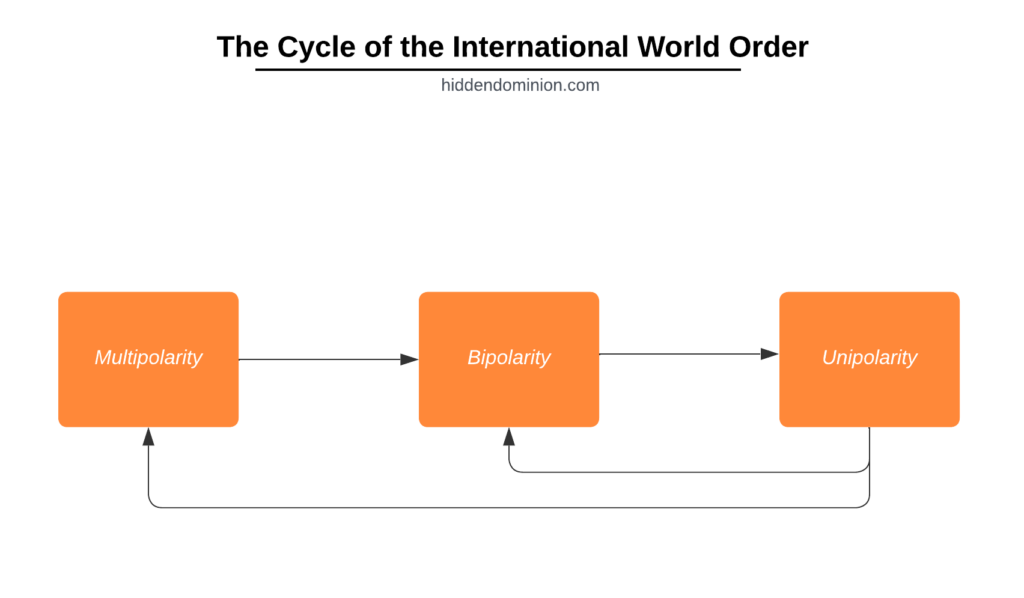
Is The International World Order Also A Cycle?
In geopolitics, we recognize three types of international systems: unipolarity, bipolarity, and multipolarity.
A broad definition of each is below:
- Unipolarity is an international system in which one state holds the majority of geopolitical power and faces no true competitors.
- Bipolarity is an international system in which two states hold the majority of geopolitical power (typically through regionalization) and often compete with one another.
- Multipolarity is an international system where three or more states hold the majority of geopolitical power.
There is major debate on which system is “best”. I think everyone, no matter their political persuasion, could find other people with a similar political leaning that hold completely opposing views on the preferred international system.
The usual debate rests between unipolarity and multipolarity. Few people favor bipolarity.
The debate between the uni/multi split largely rests on one’s perspective. The uni branch will generally favor the hegemonic stability theory, whereas the multi branch favors the balance of power theory. Both have their pros and cons. More on both later.
Here are a few pros and cons of each system, from my perspective:
- Multipolarity
- Pros: Increased need for negotiation and diplomacy, furthering temporary cooperation. A requirement for centralized regions (states) but a decentralized world. Less chance of a Babylon or one world order. Adequate at societal advancements, but not as rapid as bipolarity. Best for small/national business.
- Cons: Risk of major conflicts/alliances for a larger share of geopolitical power. Lack of stability, as national allegiances are always in fluctuation.
- Unipolarity
- Pros: World stability, for a time. Most conflicts are minor compared to multipolarity conflicts (world wars). Usually economic sanctions or diplomatic remedies are more effective at getting the non-hegemonic states in line. Best for international business.
- Cons: You could end up with an America as the unipolarity leader, leading to worldwide clown world conditions. The dominant power center exhibits increased desperation when power is being lost, leading to irrational events. Very minor societal advancement, as there are no true competitors to provoke a need for such development.
- Bipolarity
- Pros: Regional stability, for a time. Race for supremacy in both dominant states leads to major advancements. Best for regional business.
- Cons: This is a condition of continual struggle. Constant conflict occurs worldwide in various avenues (hot wars, financial conflict, cultural attacks, et cetera.) between the dominant powers. Most states are forced to pick a side, or be infiltrated by both leading powers.
Like I mentioned above, there are two dominant theories regarding the world order systems.
First, the balance of power theory:
The balance of power theory in international relations suggests that states may secure their survival by preventing any one state from gaining enough military power to dominate all others. If one state becomes much stronger, the theory predicts it will take advantage of its weaker neighbors, thereby driving them to unite in a defensive coalition. Some realists maintain that a balance-of-power system is more stable than one with a dominant state, as aggression is unprofitable when there is equilibrium of power between rival coalitions.
When threatened, states may seek safety either by balancing, allying with others against the prevailing threat; or bandwagoning, aligning themselves with the threatening power. Other alliance tactics include buck-passing and chain-ganging. Realists have long debated how the polarity of a system impacts the choice of tactics; however, it is generally agreed that in bipolar systems, each great power has no choice but to directly confront the other.
Second, the hegemonic stability theory:
Hegemonic stability theory (HST) indicates that the international system is more likely to remain stable when a single state is the dominant world power, or hegemon. Thus, the end of hegemony diminishes the stability of the international system. As evidence for the stability of hegemony, proponents of HST frequently point to the Pax Britannica and Pax Americana, as well as the instability prior to World War I (when British hegemony was in decline) and the instability of the interwar period (when the American hegemon reduced its presence from world politics).
The key mechanisms in hegemonic stability theory revolve around public goods provision: to resolve collective action problems regarding public goods, a powerful actor who is willing and able to shoulder a disproportionate share of public goods provision is needed. Hegemonic stability may entail self-reinforcing cooperation, as it is in the interest of the hegemon to provide public goods and it is in interest of other states to maintain an international order from which they derive public goods.
I personally lean multipolar (balance of power theory), mostly because of my penchant for centralized regions within a decentralized whole (communitarianism, but on an international level). Additionally, given my Christian leanings, I generally favor whatever world order is furthest from the Anti-Christ.
But I still do recognize the weaknesses inherent within a multipolar world order. The biggest weakness is the requirement of an equilibrium of power between the states, which cannot be maintained indefinitely.
However, the unipolarity system also includes similar unreasonable conditions, one of which is that the hegemon will always act in their own self-interest to provide public goods and resolve disputes in a neutral manner. Anyone that has ever paid any attention to the actions of the United States in the past few decades should easily recognize the flaw in that required condition.
Likewise, too, does the bipolarity condition face similar obstacles. A constant conflict between two dominant powers will inevitably result in one power achieving victory, leading to unipolarity.
The perceptive reader has likely already figured out where I am going with this:
- The international world order cycles just like our states and civilizations do.
The world order cycle appears to be no different from our states or civilizations. A multipolarity world order is consolidated over time into a bipolarity competition, which inevitability results in a victory, leading to a unipolarity system. The unipolarity system will often fall to multipolarity, restarting the cycle.
However, there is an exception. No different from our rule-by-one exception:
Now, for our rule-by-one exception. The rule-by-one, because of its absolute centralization status, is not linear. Rule-by-one is the stage with the most flexibility because of its absolute centralization. The exact point of absolute centralization presents a potential break in the cycle, similar to that of the rule-by-none. There are many examples of a rule-by-one -> rule-by-few, which is likely where Polybius got the original trend from. The rule-by-one can go to either the rule-by-few or the rule-by-many. This is because the absolute centralization of a state can be broken up into its component pieces or fully decentralized at the whims of the absolutist, who holds all the power to do either. Or, if he is weak, he can be taken over by the few or the masses in the same examples Polybius gives. So, a rule-by-one is a unique spot on anacyclosis, being the only point that does not follow a linear path and can go anywhere.
But the rule-by-many will always degrade into a rule-by-few, and the rule-by-few will always degrade into a rule-by-one.
The world order is the same. The unipolarity world order can break off into a bipolarity condition or a multipolarity condition, because of its absolute centralization status. But a multipolar world order will always descend into a bipolarity condition, which will lead to the unipolarity condition.
See this simple flowchart for a visual:

All this process takes is time. I took a stroll through the history of Western Civilization and this condition appears to hold, but I admittedly do need to dig deeper.
Just look at recent events:
- Multipolarity was evident pre-World War 2 (or World War 1, depending on your perspective).
- Bipolarity arose after multipolarity failed due to an improper balance of power. This existed between the Soviets and the United States.
- Unipolarity arose late into the Pax Americana era after the fall of the Soviet Union.
- We are now on track for either bipolarity or multipolarity, depending on how the dice fall regarding BRICS and the collapse of the United States.
I admit, recent events do not always tell the full story. But two other time periods follow this exact same pathway. Go check Pax Britannica:
- Multipolarity conditions were held for decades until a little while before pre-Napoleonic France.
- Bipolarity existed between France and Britain until the end of the Napoleonic Wars in 1815.
- Unipolarity of the British Empire (Pax Britannica) from 1815 until multipolarity began to creep in toward the end of the century.
- Multipolarity returned pre-World War 1/2, starting the next cycle (Pax Americana, listed above).
Pax Romana (Roman Empire during and post-Augustus) was no different. Multipolarity existed before the Roman Empire, then Rome consolidated power, beat their primary competitor, and established a clear unipolar world order condition.
In fact, the “pax x” usage itself implies hegemonic peace within the world order, indicating a unipolar world order situation. And there are many “pax x” periods throughout history, not just the ones I’ve already mentioned within Western Civilization. Here are a few:
- Pax Sinica
- Pax Hispanica
- Pax Mongolica
- Pax Ottomana
- Pax Khazarica
While historically, these generally indicate a regional (instead of world) peace, the same concept applies. A true “world order” as we understand it today did not exist back then. However, the very same conditions arose, just in regional environments. Which, back then, constituted the known or possible world for those particular regions.
Perhaps the cycle of the world order in centuries past was more of a regional or civilizational nature (Western civilization was one world order), but it is clear that in the modern era, it applies to the world as a whole. Still, we should learn from both. Especially since both demonstrate the same trend.
We can even see the gradual overlap between the regions throughout history. For instance, you can clearly see the bipolarity stages amidst the Islamic versus Christendom eras (particularly periods of the Golden Age of Islam). But these were distinct regions—Two that were rapidly coming into a newly emerging world region. Now, the entire earth is the region. But throughout history, it depended on the possible extent of reach.
There is a lot to conceptualize here, and I admit I am not yet done with this theory. But it is an interesting concept that I have found and have been pondering a lot.
If this theory is true, then according to the trend, we will be entering a multipolarity or bipolarity world order shortly. Especially given the evident decline of the States.
One thing we can take away from this review for certain is that the evolution of our world order is not linear. Like most things, it is a cycle.
While we hope to one day overcome the political cycle of collapse, I am not so sure that overcoming the cycle of the world order will be so simple.
Read Next: On Truth
If you enjoyed this article, bookmark the website and check back often for new content. New articles most weekdays.
You can also keep up with my writing by joining my monthly newsletter.
Help fight the censorship – Share this article!




